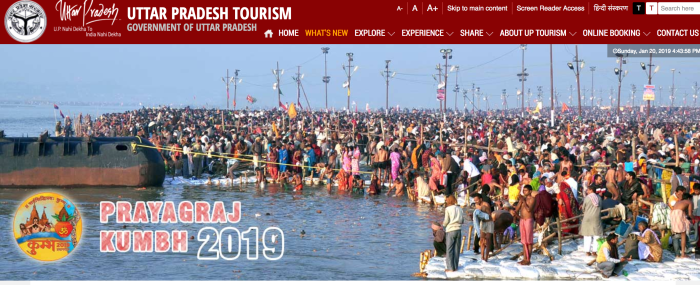
On arriving at Prayagraj we also got down to our dedicated research on Akharas and tried to know as much as possible during three days of stay. Akhara in common man’s language is the wrestling arena where wrestlers try out each other’s strength in freestyle wresting and also use the guidance and facilities attached with Akhara. In context of religious congregation this translates into a group of Sadhus and Saintly persons following Lord Shiva , Vishnu and Brahma gathered under one leading personality.
The saints and ascetics stay together and follow respective religious rituals.According to apex body Akhil Bhartiya Akhara Parishad now there are 14 Akharas which gather at Kumbh Mela. Their entries in Mela arena are in shape of majestic processions accompanied with elephants and horses with pomp and show. Mela authorities mark out respective areas of stay . Akharas come out in processions when they proceed for bath dressed in traditional Sadhu attire which in several cases is smearing of bodies with religious ash only.The movements and activities are meticulously organised and controlled to obviate chances of any clashes or conflict.
On talking to Dharam gurus and old friends we came to know that among the faithful the common belief is that Akhara tradition originates from 8th century BC when venerated Adi Shankaracharya organised seven major Akharas known as Atal, Avahan, Agni and Anand Mahanirvani, Niranjani, and Juna Akharas. It is said that the Akharas were assigned twin role of spreading and preserving religious knowledge flowing from ancient scriptures (designated as Shastradhari) and that of promoting marital arts (designated as Astradharis) to form a protective cover for religious institutions. The Akharas were reportedly conceived to act as bulwark against assault on religious institutions specially in those turbulent times when country had to face onslaughts from invading armies.
In modern times the Akharas are categorised as followers of Lord Shiva and Lord Vishnu besides followers of Brahma. In the Kumbh held in 2018 an all female Akhara comprising of Sadhvis known as Pari Akhara joined the group of famous Akahras. From the present Kumbh Akahra Parishd has reportedly added Kinnar Akhara to cover transgender Akharas . The faithfuls who chose to stay at Mela grounds as part of religious and devotional duties are known as Kalapwasi Akhara.
Below are links to some interesting processions by famous Akharas (available on U tube ) for those readers who prefer to enjoy the winter from comfort of their quilts.
 Arrival of January coinciding with Hindi month of Magh signals commencement of Kumbh Mela at Allahabad (now known as Prayagraj) , the city of Sangam (i.e. confluence of three rivers). Rigveda the ancient scripture of Hindus in India explains the importance of Kumbh Mela in mystic terms.It is believed that whoever takes a dip at Sangam the confluence of three holy rivers Ganga, Yamuna, and Saraswati at Prayagraj during the auspicious period secures a place in heaven in after life and one who sacrifices his body at Sangam during this period would attain salvation and would be free from cycle of life and death.
Arrival of January coinciding with Hindi month of Magh signals commencement of Kumbh Mela at Allahabad (now known as Prayagraj) , the city of Sangam (i.e. confluence of three rivers). Rigveda the ancient scripture of Hindus in India explains the importance of Kumbh Mela in mystic terms.It is believed that whoever takes a dip at Sangam the confluence of three holy rivers Ganga, Yamuna, and Saraswati at Prayagraj during the auspicious period secures a place in heaven in after life and one who sacrifices his body at Sangam during this period would attain salvation and would be free from cycle of life and death.



